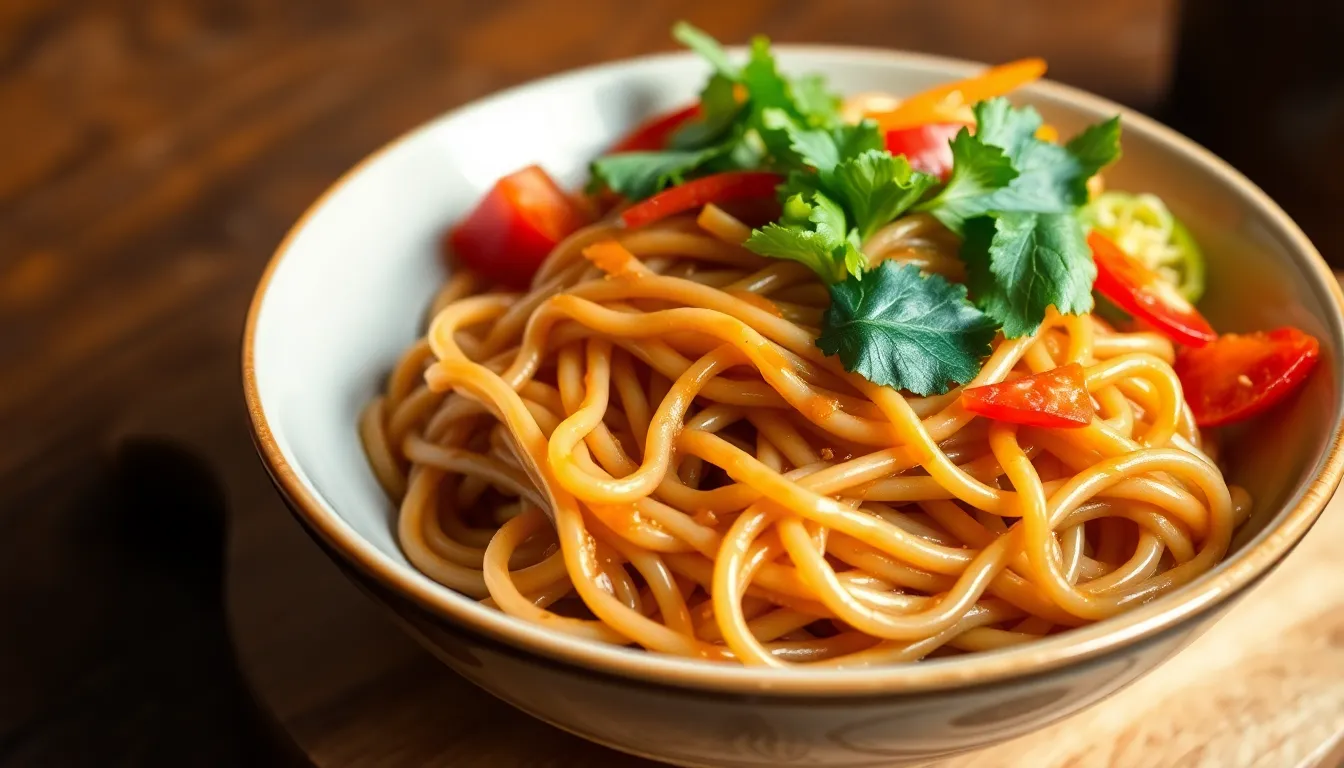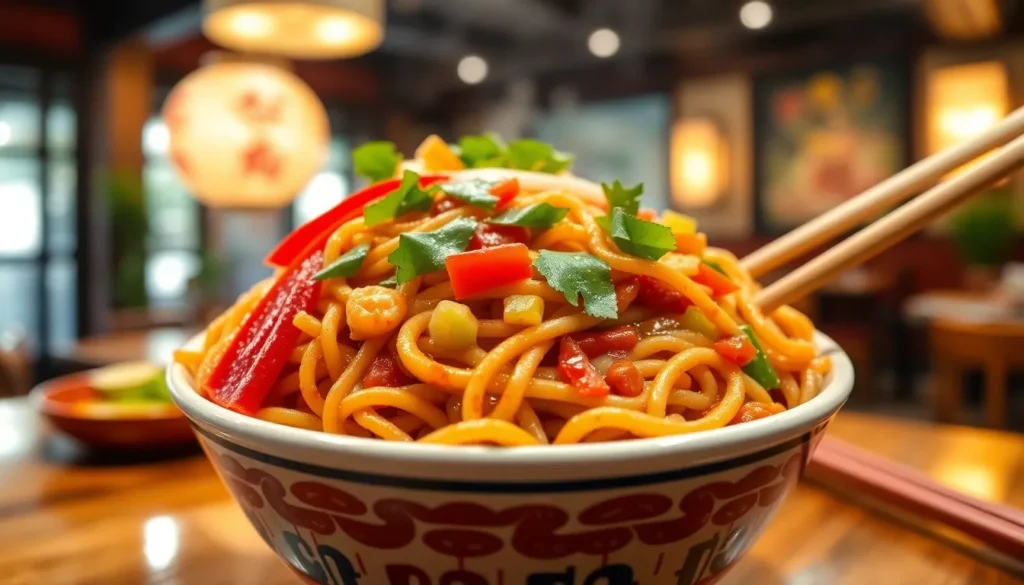Lo mein noodles are a beloved staple in Chinese cuisine, but have you ever wondered what makes these slurp-worthy strands so irresistible? Picture this: a delightful tangle of chewy noodles, glistening in savory sauces, and ready to dance with your favorite veggies and proteins. It’s a culinary love affair that’s hard to resist.
Table of Contents
ToggleOverview of Lo Mein Noodles
Lo mein noodles represent a fundamental part of Chinese culinary tradition. These versatile noodles delight with their chewy texture and ability to absorb flavors from accompanying sauces and ingredients.
Brief History of Lo Mein
Lo mein originated in China, with its roots traced back to various regional traditions that emphasize noodle dishes. The term “lo mein” translates to “stirred noodles,” referring to the method of preparation. Ancient recipes highlight the use of wheat flour and egg, creating a starchy base for these popular noodles. Initially, lo mein served as a simple staple, evolving over centuries into a beloved dish featured in restaurants globally.
Cultural Significance in Cuisine
In Chinese culture, lo mein embodies the principles of balance and harmony in meals. It frequently accompanies celebrations, representing prosperity and abundance. Diverse ingredients often showcase regional variations, allowing for creativity in pairings with meats, seafood, and vegetables. Local versions highlight the cultural influences and culinary techniques unique to each area, making lo mein an essential dish across Chinese dining experiences.
Ingredients in Lo Mein Noodles

Lo mein noodles consist of a few key ingredients that define their texture and taste. Understanding these components enhances appreciation for this traditional dish.
Primary Ingredients
Wheat flour serves as the base for lo mein noodles, providing essential structure and chewiness. Egg contributes richness to the dough, creating a more satisfying mouthfeel. Water combines with the flour and eggs to form a pliable dough. These elements blend seamlessly, resulting in noodles that can withstand vigorous stir-frying while absorbing sauces and flavors.
Common Additives
Some recipes incorporate additives for enhanced flavor. Salt often enhances the dough, balancing flavors and aiding in fermentation. Baking soda may appear to increase elasticity, resulting in a desirable texture. Other variations might include ingredients like spinach or beet juice, yielding colorful noodles that appeal visually while offering additional nutrients. Each additive plays a role in elevating the lo mein experience, making these noodles versatile and delightful.
Nutritional Information
Lo mein noodles provide a unique blend of nutrients contributing to a balanced diet. Understanding their caloric content and health benefits offers valuable insights for those enjoying this dish.
Caloric Content
Lo mein noodles contain approximately 200 to 300 calories per serving, depending on ingredients and preparation methods. Most of these calories come from carbohydrates, mainly derived from wheat flour. Protein content usually ranges from 6 to 8 grams, attributed to the eggs in the dough. Fat content remains relatively low, averaging 2 to 5 grams per serving, particularly if sauces and oils are minimal. Nutritional values can vary when additional vegetables and proteins are included, enhancing the overall caloric count.
Health Benefits
Lo mein noodles offer several health benefits when consumed as part of a balanced diet. Whole wheat variations provide dietary fiber, promoting digestive health and aiding in weight management. The presence of eggs enriches the dish with essential amino acids, which support muscle maintenance and repair. Incorporating vegetables into lo mein further increases vitamin and mineral intake, supporting overall wellness. These nutrients contribute to energy levels, improved immune function, and better skin health, making lo mein an appealing option for those seeking balanced meals.
Different Types of Lo Mein Noodles
Lo mein noodles vary in type and preparation across different regions. Regional variations bring unique flavors and textures to the dish.
Variations Based on Region
In Cantonese cuisine, lo mein noodles tend to be slightly thicker and chewier. Northern Chinese regions often use egg noodles, which add richness and flavor. Some areas, like Sichuan, incorporate spicy ingredients, creating a more intense dish. Throughout Southeast Asia, adaptations include local ingredients, making lo mein a versatile dish enjoyed in multiple countries. Regional influences shape the way lo mein enriches local culinary traditions and preferences.
Popular Adaptations
Popular adaptations of lo mein include a variety of proteins and vegetables. Chicken, beef, and shrimp frequently serve as primary protein sources. Vegetarians often enjoy tofu or a medley of colorful vegetables like bell peppers, broccoli, and carrots. Different sauces, from classic soy and oyster to modern teriyaki, enhance flavor profiles. Additionally, gluten-free alternatives made with rice noodles or vegetable noodles cater to specific dietary needs. These adaptations reflect individual preferences, making lo mein a customizable dish for any palate.
Cooking Techniques
Cooking lo mein noodles involves various methods that enhance their flavor and texture. Techniques range from traditional stir-frying to modern adaptations, allowing for flexibility in preparation.
Traditional Methods
Traditional cooking methods involve boiling or steaming lo mein noodles until tender. After they reach the desired texture, chefs toss them in a skillet over high heat with vegetables and protein. Stir-frying with oil and traditional Chinese sauces creates a rich fusion of flavors. Garnishing with green onions and sesame seeds adds visual appeal and an extra layer of taste. Using a wok facilitates even cooking, allowing the noodles to absorb the sauce thoroughly. Mastering these techniques can bring out the authentic flavors cherished in Chinese cuisine.
Modern Twists
Modern cooking techniques introduce innovative approaches to lo mein preparation. Chefs experiment with spiralized vegetables, offering a gluten-free alternative to traditional noodles. Incorporating sous-vide methods creates precision cooking for proteins. Grilling ingredients before stirring them into the noodles adds depth and smokiness. Creative sauce combinations, such as peanut or chili garlic, offer unexpected flavor profiles. These modern twists cater to diverse dietary preferences while maintaining the essence of lo mein.
Lo mein noodles are more than just a simple dish; they embody a rich culinary tradition that has evolved over centuries. Their unique texture and flavor make them a staple in kitchens around the world. With a variety of ingredients and cooking techniques, lo mein offers endless possibilities for customization, catering to diverse tastes and dietary needs.
Whether enjoyed in a traditional setting or with modern twists, lo mein continues to be a beloved choice for those seeking a satisfying and nutritious meal. The balance of flavors and textures in lo mein not only delights the palate but also reflects the harmony and prosperity that Chinese cuisine celebrates.





